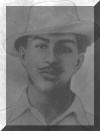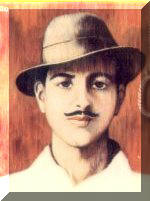Bhagat Singh
The finest youth India
ever had !!
One evening a boy of
three was out for a walk with his father. There was also an elderly man with the
father. Chatting they walked on and went beyond the village. Green crop
delighted the eyes. The elders were walking along the edge of a field. Not
hearing the footsteps of the boy, the father looked back. The boy was sitting on
the ground and seemed to be planting some thing. The father became curious.
"What are you doing?" said he.
"Look, father, I shall grow guns all over the field" was the innocent reply of
the boy. His eyes shone with the strong faith that guns would grow in the field.
Both the elders were struck with wonder at the little boy's words.
The boy was Bhagat Singh who later fought like a hero for India's freedom and
sacrificed his life.
Bhagat Singh was born in a
Sikh family of farmers in the village of Banga of Layalpur district of Punjab
(now in Pakistan) on September 27th of 1907. His family stood for patriotism,
reform, and freedom of the country. His grandfather Arjun Singh was drawn to
Arya Samaj, a reformist movement of Hinduism, and took keen interest in
proceedings of the Indian National Congress. Bhagat Singh's father Kishen Singh
and uncle Ajit Singh were members of Ghadr Party founded in the U.S. in early
years of this century to route British rule in India. Both were jailed for
alleged anti-British activities. Ajit Singh had 22 cases against him and was
forced to flee to Iran. Thereafter he went to Turkey, Austria, Germany and
finally to Brazil to escape Black Water (Kalapani) punishment for his
revolutionary activities in India.
Young Bhagat Singh was brought up in a politically charged state of Punjab which
was left with a seething memory of the Jalianwala massacre of more than 400
innocent lives and thousands injured (1919). As a lad of fourteen he went to
this spot to collect soil from the park of Jalianwala (bagh) in his lunch box,
sanctified by the blood of the innocent and kept it as a memento for life.
Bhagat Singh was studying at the National College founded by Lala Lajpatrai, a
great revolutionary leader and reformist. To avoid early marriage, he ran away
from home and, became a member of the youth organization Noujawan Bharat Sabha
which had memberships of all sects and religions. He met Chandra Shekhar Sharma
(Azad), B.K. Dutt and other revolutionaries. They used to print handouts and
newspapers in secret and spread political awareness in India through Urdu,
Punjabi and English. These were all banned activities in India at the time,
punishable with imprisonment.
The Simon Commission, Murder of Lala Lajpatrai and the Revenge
Anti-British feelings were spreading; Indians wanted some proper representation
in running the administration of their country to which British reciprocated
only on paper. Noticing restlessness was spreading, the British Government
appointed a commission under the leadership of Sir John Simon in 1928, to report
on political happenings. There was no single Indian member in this commission,
and all the political parties decided to boycott the commission when it planned
to visit major cities of India.
In Lahore, Lala Lajpatrai (picture) and Pandit Madan Mohan Malavia decided to
protest to the commission in open about their displeasure. It was a silent
protest march, yet the police chief Scott had banned meetings or processions.
Thousands joined, without giving room for any untoward incident. Even then,
Scott beat Lala Lajpatrai severely with a lathi (bamboo stick) on the head
several times. Finally the leader succumbed to the injuries.
Bhagat Singh who was an eye witness to the morbid scene vowed to take revenge
and with the help of Azad, Rajguru and Sukhadev plotted to kill Scott.
Unfortunately he killed Mr. Sanders, a junior officer, in a case of mistaken
identity. He had to flee from Lahore to escape death punishment.
Instead of finding the root cause for discontent of Indians, the British
government took to more repressive measures. Under the Defense of India Act, it
gave more power to the police to arrest persons to stop processions with
suspicious movements and actions. The act brought in the council was defeated by
one vote. Even then it was to be passed in the form of an ordinance in the
"interest of the public." No doubt the British were keen to arrest all leaders
who opposed its arbitrary actions, and Bhagat Singh who was in hiding all this
while, volunteered to throw a bomb in the central assembly where the meeting to
pass the ordinance was being held. It was a carefully laid out plot, not to
cause death or injury but to draw the attention of the government, that the
modes of its suppression could no more be tolerated. It was agreed that Bhagat
Singh and Batukeshwar Dutt would court arrest after throwing the bomb.
It was a forgone conclusion in 1929 April 8th at Delhi Central Assembly. Singh
and Dutt threw handouts, and bombed in the corridor not to cause injury and
courted arrest after shouting slogans Inquilab Zindabad (Long Live, Revolution!)
Meanwhile the killers of Sanders were identified by the treachery of Bhagat
Singh's friends who became "Approvers." Bhagat Singh thought the court would be
a proper venue to get publicity for the cause of freedom, and did not want to
disown the crime. But he gave a fiery statement giving reasons for killing which
was symbolic of freedom struggle. He wanted to be shot like a soldier, and not
die at the gallows. But, his plea was rejected, and he was hanged on the 23rd of
March 1931. He was 24.
Bhagat Singh became a legendary hero for the masses. Innumerable songs were
composed about him, and the youth throughout the country made him their ideal.
He became a symbol of bravery and a goal to free India.
Dear visitor, I will add more to the section as and when I get time. But
please do send in your comments and criticisms.

